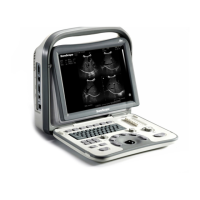A6T/A6/A5 Portable Ultrasonic Diagnostic System
4701-0040-01A
5-6
5.2.2 Cleaning
Every time using the transducer, clean the transducer handle, and disinfect
the endocavity transducer with chemical disinfectant.
Remove the ultrasound gel on the transducer with soft cloth, and wash away
any residue on the transducer with running water. Then clean the transducer
with warm moderate suds. If necessary, clean the transducer and remove the
visible residue on the surface of the endocavity transducer with soft cloth.
Clean the transducer with sufficient clean drinking water, wash away visible
suds residue on the transducer, and air dry it.
NOTE:
1. Before cleaning the transducer, remove the protective cover on the
transducer (e.g. disposable condom).
2. During the cleaning of endocavity transducer, it is important to ensure
that all surfaces of the endocavity transducer is cleaned thoroughly.
5.2.3 Disinfection
The transducer shall be disinfected with liquid chemical disinfectant (e.g.
glutaraldehyde solution) approved by the FDA. The solution shall be mixed,
stored and used following its manufacturer’s product instruction. It is effective
to disinfect transducers with 2% glutaraldehyde solution, which is considered
to be the disinfectant most compatible to transducer material.
Do not process the transducer with high-pressure steam or have it contact
any ethylene oxide. In no circumstances shall heat disinfection be applied.
Temperature higher than 150 F (66 ) may damage the transducer. ℃
Immerse the transducer head in the disinfectant for not less than 20 minutes,
but no more than 1 hour. The immersion section shall not exceed the
transducer bonding boundary. The transducer should not be immersed in any
liquid completely, otherwise it may lead to permanent damage.

